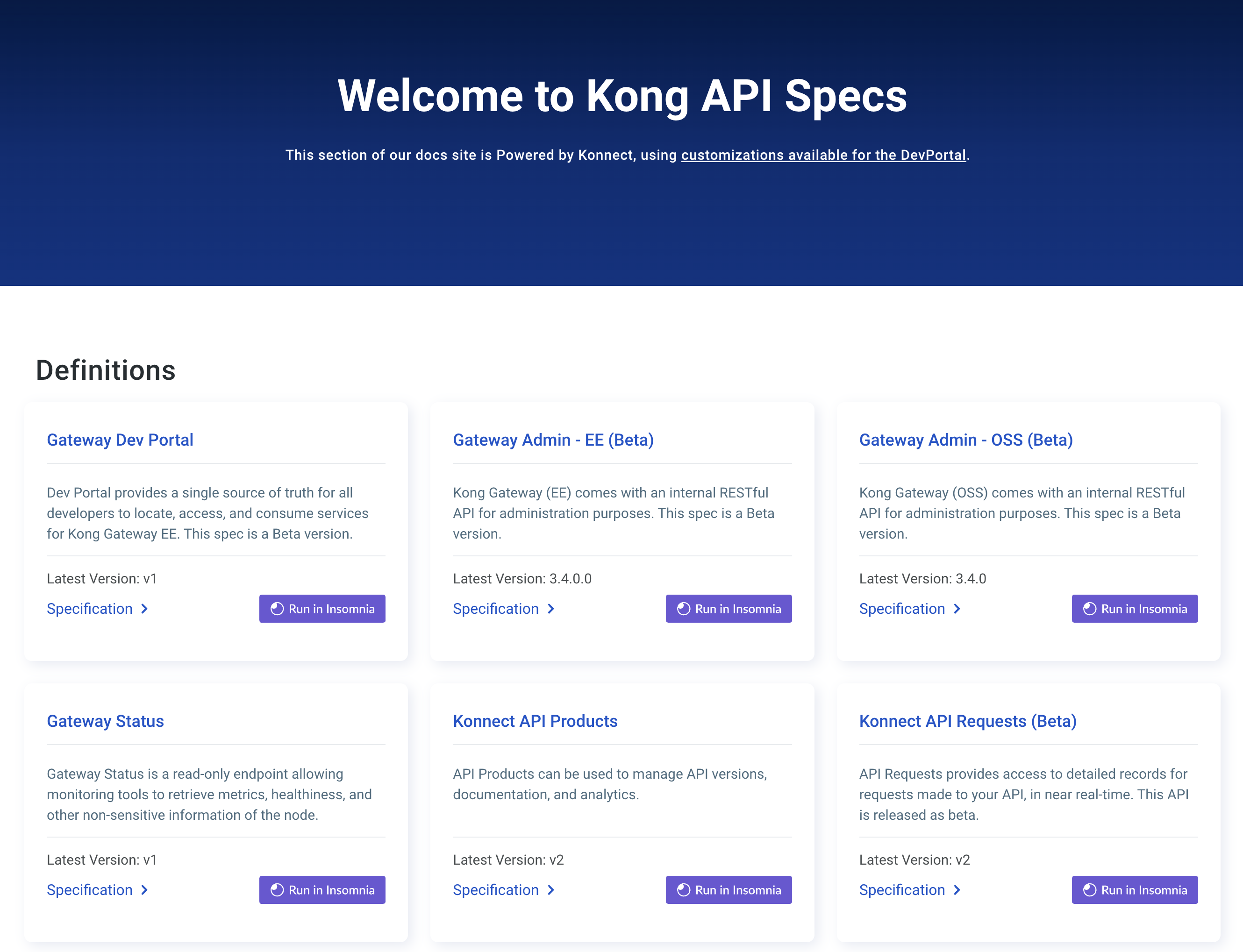このページは、まだ日本語ではご利用いただけません。翻訳中です。
旧バージョンのドキュメントを参照しています。 最新のドキュメントはこちらをご参照ください。
Kubernetes Gateway API
Kong Mesh supports Kubernetes Gateway API for configuring built-in gateway as well as traffic routing using the experimental GAMMA routing spec.
Installation
Kong Mesh’s Kubernetes Gateway API implementation is beta.
Gateway API
Gatewaysaren’t supported in multi-zone. To use the builtin Gateway, you need to use theMeshGatewayresources.
-
Install the Gateway API CRDs.
Kubernetes doesn’t include Gateway API CRDs, install them from the standard channel CRD bundle.
-
Enable Gateway API support.
- With
kumactl, use the--experimental-gatewayapiflag. - With Helm, use the
kuma.experimental.gatewayAPI=truevalue.
- With
Gateways
-
Install the counter demo.
kumactl install demo --without-gateway | kubectl apply -f - -
Add a
Gateway.The
Gatewayresource represents the proxy instance that handles traffic for a set of Gateway API routes.Every
Gatewayrefers to aGatewayClass. TheGatewayClassrepresents the class ofGateway, in this case Kong Mesh’s builtin edge gateway, and points to a controller that should manage theseGateways. It can also hold additional configuration.For Helm and
kumactlinstallations, aGatewayClassnamedkumais automatically installed if the Gateway API CRDs are present.apiVersion: gateway.networking.k8s.io/v1 kind: Gateway metadata: name: kuma namespace: kuma-demo spec: gatewayClassName: kuma listeners: - name: proxy port: 8080 protocol: HTTPWhen a user applies a
Gatewayresource, Kong Mesh automatically creates aDeploymentof built-in gateways with a correspondingService.kubectl get pods -n kuma-demoNAME READY STATUS RESTARTS AGE redis-59c9d56fc-6gcbc 2/2 Running 0 2m8s demo-app-5845d6447b-v7npw 2/2 Running 0 2m8s kuma-4j6wr-58998b5576-25wl6 1/1 Running 0 30skubectl get svc -n kuma-demoNAME TYPE CLUSTER-IP EXTERNAL-IP PORT(S) AGE redis ClusterIP 10.43.223.223 <none> 6379/TCP 3m27s demo-app ClusterIP 10.43.216.203 <none> 5000/TCP 3m27s kuma-pfh4s LoadBalancer 10.43.122.93 172.20.0.3 8080:30627/TCP 87sThe
Gatewayis now accessible using the external address172.20.0.3:8080. -
Add an
HTTPRoute.HTTPRouteresources contain a set of matching criteria for HTTP requests and upstreamServicesto route those requests to.apiVersion: gateway.networking.k8s.io/v1 kind: HTTPRoute metadata: name: echo namespace: kuma-demo spec: parentRefs: - group: gateway.networking.k8s.io kind: Gateway name: kuma namespace: kuma-demo rules: - backendRefs: - kind: Service name: demo-app port: 5000 weight: 1 matches: - path: type: PathPrefix value: /After creating an
HTTPRoute, accessing/forwards a request to the demo app:curl 172.20.0.3:8080/ -iHTTP/1.1 200 OK x-powered-by: Express accept-ranges: bytes cache-control: public, max-age=0 last-modified: Tue, 20 Oct 2020 17:16:41 GMT etag: W/"2b91-175470350a8" content-type: text/html; charset=UTF-8 content-length: 11153 date: Fri, 18 Mar 2022 11:33:29 GMT x-envoy-upstream-service-time: 2 server: Kuma Gateway <html> <head> ...
TLS termination
Gateway API supports TLS termination by using standard kubernetes.io/tls Secrets.
Here is an example
apiVersion: v1
kind: Secret
metadata:
name: secret-tls
namespace: kuma-demo
type: kubernetes.io/tls
data:
tls.crt: "MIIEOzCCAyO..." # redacted
tls.key: "MIIEowIBAAKC..." # redacted
apiVersion: gateway.networking.k8s.io/v1
kind: Gateway
metadata:
name: kuma
namespace: kuma-demo
spec:
gatewayClassName: kuma
listeners:
- name: proxy
port: 8080
hostname: test.kuma.io
protocol: HTTPS
tls:
certificateRefs:
- name: secret-tls
Under the hood, Kong Mesh CP copies the Secret to kong-mesh-system namespace and converts it to Kong Mesh secret.
It tracks all the changes to the secret and deletes it upon deletion of the original secret.
Customization
Gateway API provides the parametersRef field on GatewayClass.spec
to provide additional, implementation-specific configuration to Gateways.
When using Gateway API with Kong Mesh, you can refer to a MeshGatewayConfig resource:
apiVersion: gateway.networking.k8s.io/v1
kind: GatewayClass
metadata:
name: kuma
spec:
controllerName: gateways.kuma.io/controller
parametersRef:
kind: MeshGatewayConfig
group: kuma.io
name: kuma
This resource has the same structure as the MeshGatewayInstance resource
except that the tags field is optional.
With a MeshGatewayConfig you can then customize
the generated Service and Deployment resources.
Multi-mesh
You can specify a Mesh for Gateway and HTTPRoute resources
by setting the kuma.io/mesh annotation
Note that HTTPRoutes must also have the annotation to reference a
Gateway from a non-default Mesh.
Cross-mesh
Cross-mesh gateways are supported with Gateway API.
You’ll just need to create a corresponding GatewayClass
pointing to a MeshGatewayConfig that
sets crossMesh: true:
apiVersion: gateway.networking.k8s.io/v1
kind: GatewayClass
metadata:
name: kuma-cross-mesh
spec:
controllerName: gateways.kuma.io/controller
parametersRef:
group: kuma.io
kind: MeshGatewayConfig
name: default-cross-mesh
---
apiVersion: kuma.io/v1alpha1
kind: MeshGatewayConfig
metadata:
name: default-cross-mesh
spec:
crossMesh: true
and then reference it in your Gateway:
apiVersion: gateway.networking.k8s.io/v1
kind: Gateway
metadata:
name: kuma
namespace: default
spec:
gatewayClassName: kuma-cross-mesh
listeners:
- name: proxy
port: 8080
protocol: HTTP
Multi-zone Deployments
Gateway API isn’t supported with multi-zone deployments, use Kong Mesh’s MeshGateways/MeshHTTPRoute/
MeshTCPRoute instead.
Service to service routing
Kong Mesh also supports routing between services with
HTTPRoute in conformance with
the GAMMA specifications.
GAMMA is a Gateway API subproject focused on mesh implementations of Gateway API and extending the Gateway API resources to mesh use cases.
GAMMA in Kong Mesh is experimental!
The key feature of HTTPRoute for mesh routing is specifying a Kubernetes
Service as the parentRef, as opposed to a Gateway.
All requests to this Service are then filtered and routed as specified in the
HTTPRoute.
apiVersion: gateway.networking.k8s.io/v1
kind: HTTPRoute
metadata:
name: canary-demo-app
namespace: kuma-demo
spec:
parentRefs:
- name: demo-app
port: 5000
kind: Service
rules:
- backendRefs:
- name: demo-app-v1
port: 5000
- name: demo-app-v2
port: 5000
The namespace of the HTTPRoute is key. If the route’s namespace and the
parentRef’s namespace are identical, Kong Mesh applies
the route to requests from all workloads.
If the route’s namespace differs from its parentRef’s namespace,
the HTTPRoute applies only to requests
from workloads in the route’s namespace.
Remember to tag your
Serviceports withappProtocol: httpto use them in anHTTPRoute!
Because of how Kuma maps resources at the moment, the combination of the
HTTPRoutes name and namespace and the parentServicename and namespace must be no more than 249 characters.
How it works
Kong Mesh includes controllers that reconcile Gateway API CRDs and convert them into the corresponding Kong Mesh CRDs.
This is why in the GUI, Kong Mesh MeshGateways/MeshGatewayRoutes/MeshHTTPRoutes/MeshTCPRoutes are visible and not Kubernetes Gateway API resources.
Kubernetes Gateway API resources serve as the source of truth for Kong Mesh gateways and routes. Any edits to the corresponding Kong Mesh resources are overwritten.












